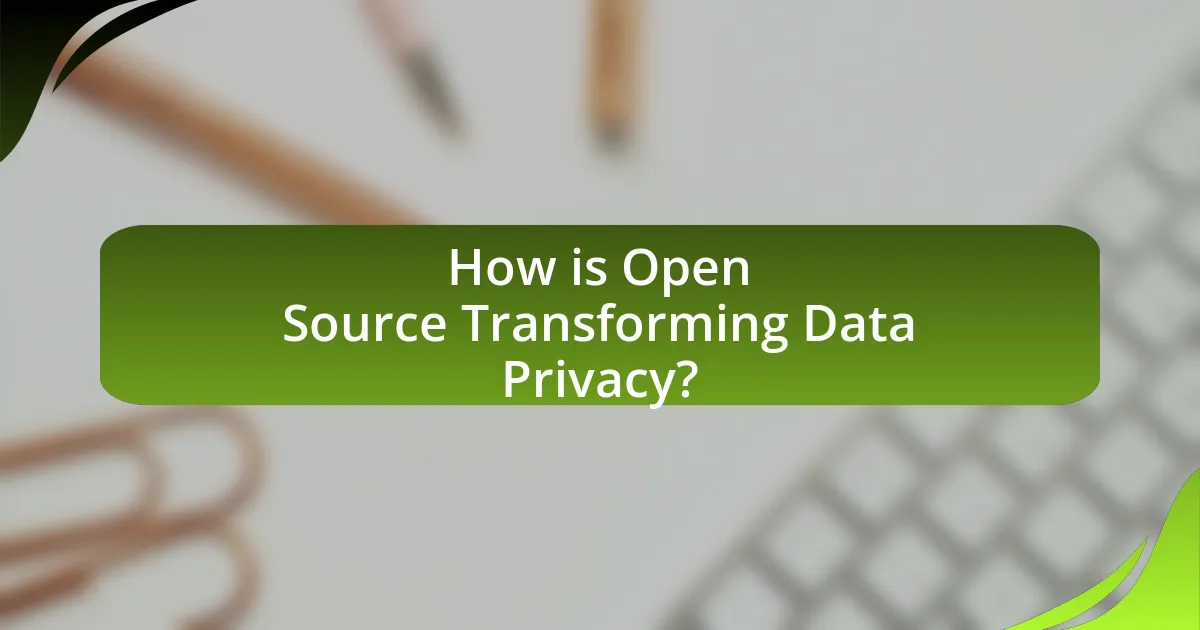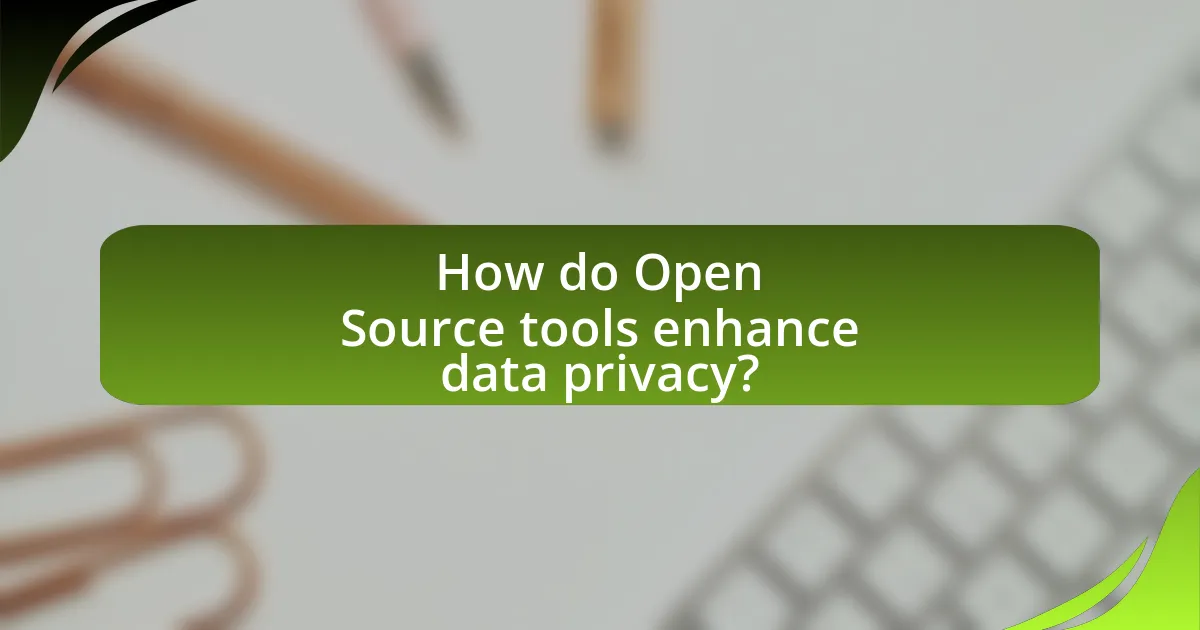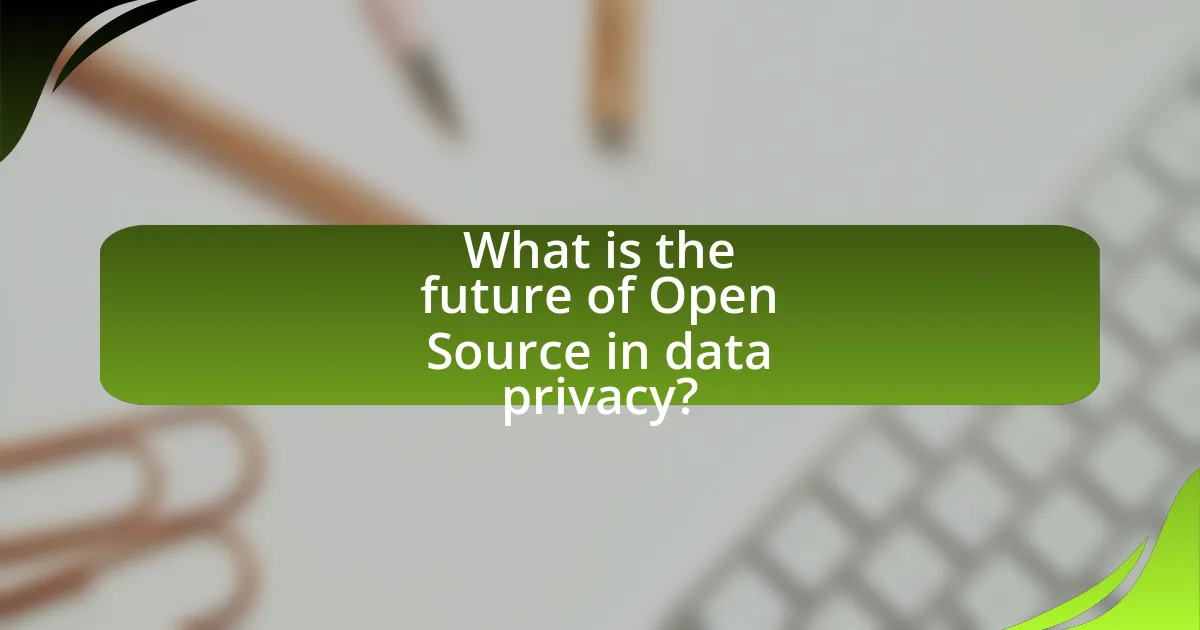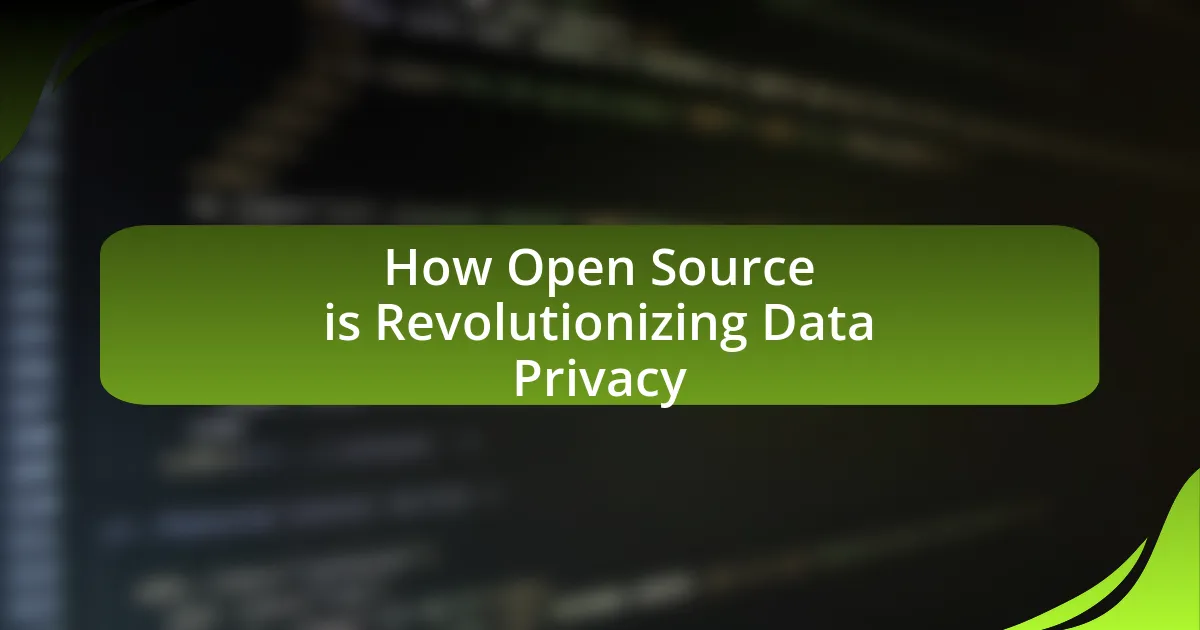Open source is fundamentally transforming data privacy by promoting transparency, user control, and community collaboration. This article explores how open source software enables users to inspect and modify code, leading to enhanced security and privacy features, as demonstrated by projects like Mozilla Firefox and Signal. It discusses the principles of open source in relation to data privacy, the role of community collaboration in identifying vulnerabilities, and the advantages of open source over proprietary solutions. Additionally, it addresses the challenges faced by open source in maintaining data privacy and highlights popular tools that enhance user privacy through encryption and anonymity. The article concludes by examining the future of open source in the evolving landscape of data privacy regulations and standards.

How is Open Source Transforming Data Privacy?
Open source is transforming data privacy by enabling transparency and community-driven security improvements. Open source software allows users to inspect, modify, and enhance the code, which fosters trust as vulnerabilities can be identified and addressed by a global community of developers. For instance, projects like Mozilla Firefox and Signal have demonstrated how open source can lead to robust privacy features, as their code is publicly available for scrutiny and improvement. Additionally, the use of open source tools in data protection, such as encryption libraries, empowers organizations to implement strong privacy measures without relying on proprietary solutions that may have hidden flaws. This shift towards open source not only enhances individual privacy but also promotes a culture of accountability and collaboration in the tech community.
What are the fundamental principles of Open Source in relation to data privacy?
The fundamental principles of Open Source in relation to data privacy include transparency, user control, and community collaboration. Transparency allows users to inspect the source code, ensuring that data handling practices are visible and verifiable. User control empowers individuals to manage their own data, as Open Source software often includes features that enable users to decide how their information is collected and used. Community collaboration fosters a collective effort to identify and address privacy vulnerabilities, leading to more robust security measures. These principles are supported by the Open Source Initiative, which emphasizes the importance of open access to software for enhancing user privacy and security.
How does transparency in Open Source contribute to data privacy?
Transparency in Open Source enhances data privacy by allowing users to inspect, modify, and audit the source code for vulnerabilities and data handling practices. This openness enables a community of developers and security experts to identify and address potential privacy issues more effectively than in proprietary software, where the code is hidden. For instance, studies have shown that open-source projects often have faster response times to security vulnerabilities due to community collaboration, as seen in the rapid patching of the Heartbleed bug in OpenSSL. This collective scrutiny fosters trust and accountability, ensuring that data privacy measures are not only implemented but also verifiable by independent parties.
What role does community collaboration play in enhancing data privacy?
Community collaboration plays a crucial role in enhancing data privacy by fostering collective knowledge sharing and developing robust privacy solutions. When individuals and organizations collaborate, they can identify vulnerabilities, share best practices, and create open-source tools that improve data protection. For instance, projects like the Tor network, which relies on community contributions, provide anonymity and secure communication, demonstrating how collaborative efforts can lead to significant advancements in privacy technologies. Additionally, community-driven audits and transparency initiatives help hold organizations accountable, ensuring that data privacy standards are upheld.
Why is Open Source considered a viable alternative for data privacy solutions?
Open Source is considered a viable alternative for data privacy solutions because it allows for transparency and community-driven development. This transparency enables users to inspect the source code for vulnerabilities, ensuring that no hidden backdoors or malicious features exist. Additionally, community contributions often lead to faster identification and resolution of security issues, as seen in projects like Linux and Apache, which have robust security track records due to their open nature. Furthermore, Open Source solutions can be customized to meet specific privacy needs, providing users with greater control over their data compared to proprietary software, which may have undisclosed data handling practices.
What advantages does Open Source offer over proprietary software in terms of data privacy?
Open source software offers significant advantages over proprietary software in terms of data privacy due to its transparency and community-driven development. The open nature of source code allows users to inspect, modify, and enhance the software, ensuring that any potential vulnerabilities or privacy issues can be identified and addressed by anyone, not just the original developers. This collaborative approach fosters a more secure environment, as seen in projects like the Linux operating system, which has undergone extensive scrutiny by a global community, leading to robust security features. Additionally, open source software typically does not include hidden data collection practices, which are often present in proprietary solutions, thereby giving users greater control over their data. This control is further supported by the ability to host the software on personal servers, minimizing reliance on third-party services that may compromise data privacy.
How does Open Source empower users to control their own data?
Open Source empowers users to control their own data by providing access to the source code of software, allowing users to modify, inspect, and enhance the software according to their needs. This transparency enables users to understand how their data is handled, ensuring that they can implement privacy measures and security protocols that align with their preferences. For instance, studies have shown that open-source software, such as Nextcloud, allows users to host their own data storage solutions, thereby eliminating reliance on third-party services that may misuse or mishandle personal information. This control over the software environment directly translates to greater autonomy over personal data management.
What challenges does Open Source face in the realm of data privacy?
Open Source faces significant challenges in the realm of data privacy, primarily due to its transparency and collaborative nature. This openness can inadvertently expose vulnerabilities, as malicious actors can analyze the code for weaknesses. Additionally, the lack of centralized control in many Open Source projects complicates the enforcement of consistent data privacy standards, leading to potential non-compliance with regulations such as GDPR. Furthermore, contributors may not always prioritize privacy, resulting in features that inadequately protect user data. These factors collectively hinder the ability of Open Source solutions to ensure robust data privacy.
How do security vulnerabilities impact Open Source data privacy solutions?
Security vulnerabilities significantly undermine the effectiveness of Open Source data privacy solutions by exposing sensitive user information to potential breaches. When vulnerabilities exist in the code, malicious actors can exploit these weaknesses to gain unauthorized access to data, leading to privacy violations. For instance, the 2014 Heartbleed bug in OpenSSL, an open-source library, allowed attackers to read sensitive data from the memory of affected servers, impacting countless websites and services. This incident illustrates how a single vulnerability can compromise the integrity of data privacy solutions, eroding user trust and potentially resulting in legal repercussions for organizations. Thus, the presence of security vulnerabilities directly correlates with the reliability and safety of Open Source data privacy solutions.
What are the misconceptions surrounding Open Source and data privacy?
A common misconception surrounding Open Source and data privacy is that Open Source software inherently lacks security and privacy protections. This belief stems from the idea that because the source code is publicly accessible, it is more vulnerable to exploitation. However, studies have shown that Open Source projects often undergo rigorous peer review and community scrutiny, which can lead to quicker identification and resolution of security vulnerabilities compared to proprietary software. For instance, a 2020 report by the Open Source Security Foundation highlighted that Open Source software can be more secure due to its transparency, allowing for collaborative improvements and faster patching of security flaws.

How do Open Source tools enhance data privacy?
Open Source tools enhance data privacy by allowing users to inspect, modify, and control the software they use, which reduces the risk of hidden vulnerabilities and malicious code. This transparency enables a community of developers and security experts to audit the code, identify security flaws, and implement fixes more rapidly than proprietary software. For instance, studies have shown that open-source software can have fewer vulnerabilities due to the collaborative nature of its development, as seen in projects like Linux and Apache, which have robust security records. Additionally, users can customize these tools to meet their specific privacy needs, ensuring that data handling practices align with their personal or organizational privacy standards.
What are some popular Open Source tools focused on data privacy?
Some popular open source tools focused on data privacy include Nextcloud, Tor, and CryptPad. Nextcloud provides a secure file sharing and collaboration platform that emphasizes user control over data. Tor enables anonymous browsing by routing internet traffic through a network of volunteer-operated servers, enhancing user privacy. CryptPad offers a suite of collaborative tools that encrypt data end-to-end, ensuring that only users have access to their information. These tools are widely recognized for their commitment to protecting user privacy and data security.
How do these tools implement encryption to protect user data?
These tools implement encryption to protect user data by utilizing advanced cryptographic algorithms that secure data both at rest and in transit. For instance, many open-source tools employ AES (Advanced Encryption Standard) for encrypting stored data, ensuring that unauthorized access is prevented. Additionally, during data transmission, protocols like TLS (Transport Layer Security) are commonly used to encrypt the data being sent over networks, safeguarding it from interception. The effectiveness of these encryption methods is supported by their widespread adoption in security standards and compliance frameworks, which validate their reliability in protecting sensitive information.
What features do these tools offer to ensure user anonymity?
Open source tools ensure user anonymity through features such as end-to-end encryption, which protects data from unauthorized access during transmission. Additionally, these tools often implement decentralized networks, reducing reliance on central servers that could compromise user identities. Many open source applications also include options for anonymous browsing, such as Tor integration, which masks users’ IP addresses. Furthermore, they typically allow users to control their data, enabling them to choose what information to share and with whom. These features collectively enhance user privacy and security, making it difficult for third parties to track or identify individuals.
How can organizations effectively implement Open Source solutions for data privacy?
Organizations can effectively implement Open Source solutions for data privacy by adopting a structured approach that includes evaluating existing Open Source tools, ensuring compliance with data protection regulations, and fostering a culture of transparency and collaboration. Evaluating tools such as Nextcloud for secure file sharing or Matomo for web analytics allows organizations to select solutions that align with their privacy needs. Compliance with regulations like GDPR is essential, as Open Source software often provides the flexibility to customize data handling practices. Furthermore, fostering a culture of transparency encourages community contributions and peer reviews, enhancing the security and reliability of the implemented solutions. This approach is supported by the growing adoption of Open Source software in sectors prioritizing data privacy, as evidenced by a 2021 report from the Open Source Initiative, which highlighted a 30% increase in organizations using Open Source for privacy-focused applications.
What best practices should organizations follow when adopting Open Source tools?
Organizations should follow several best practices when adopting Open Source tools to ensure effective implementation and security. First, they should conduct thorough evaluations of the tools to assess their security, community support, and compliance with licensing requirements. For instance, a study by the Linux Foundation in 2020 highlighted that 90% of organizations reported security vulnerabilities in Open Source software, emphasizing the need for careful selection.
Second, organizations should establish a governance framework that includes policies for contribution, usage, and maintenance of Open Source projects. This framework helps in managing risks associated with Open Source adoption, as noted in the 2021 Open Source Security and Risk Analysis report, which found that organizations with governance frameworks experienced fewer security incidents.
Third, organizations should invest in training and resources for their teams to ensure they have the necessary skills to work with Open Source tools effectively. According to a 2022 survey by GitHub, 70% of developers felt more confident using Open Source tools when they received proper training.
Finally, organizations should actively participate in the Open Source community to contribute back and stay updated on best practices and security patches. Engaging with the community fosters collaboration and enhances the overall security posture of the tools being used.
How can organizations contribute to the Open Source community to improve data privacy?
Organizations can contribute to the Open Source community to improve data privacy by developing and sharing privacy-focused software tools and frameworks. By actively participating in collaborative projects, organizations can enhance the security features of existing open-source solutions, ensuring they meet high data protection standards. For instance, contributions to projects like OpenSSL or Mozilla Firefox have historically led to significant improvements in encryption and user privacy features, benefiting a wide range of users. Additionally, organizations can sponsor research and development initiatives that focus on privacy-enhancing technologies, fostering innovation in the open-source ecosystem. This collaborative approach not only strengthens the tools available for data privacy but also promotes transparency and trust within the community.

What is the future of Open Source in data privacy?
The future of Open Source in data privacy is promising, as it fosters transparency, collaboration, and innovation in developing privacy-focused solutions. Open Source projects, such as the GNU Privacy Guard and the Tor Project, exemplify how community-driven efforts can enhance data protection by allowing users to inspect, modify, and improve the underlying code. This collaborative approach not only accelerates the identification of vulnerabilities but also encourages the adoption of best practices in data security. Furthermore, the increasing regulatory emphasis on data privacy, such as the General Data Protection Regulation (GDPR) in Europe, is likely to drive demand for Open Source tools that provide users with greater control over their personal information. As organizations seek to comply with these regulations while maintaining user trust, Open Source solutions will play a critical role in shaping the future landscape of data privacy.
How is the landscape of data privacy evolving with Open Source initiatives?
The landscape of data privacy is evolving significantly due to Open Source initiatives, which promote transparency and community-driven development. Open Source software allows users to inspect, modify, and enhance code, leading to more secure and privacy-focused applications. For instance, projects like Nextcloud and Signal have gained traction by prioritizing user data protection and offering alternatives to proprietary solutions that may compromise privacy. According to a 2021 report by the Open Source Initiative, 78% of organizations believe that Open Source software enhances their data privacy posture, highlighting its role in fostering trust and accountability in data handling practices.
What emerging trends should we watch for in Open Source data privacy solutions?
Emerging trends in Open Source data privacy solutions include increased adoption of decentralized identity systems, enhanced encryption protocols, and the integration of artificial intelligence for data protection. Decentralized identity systems, such as those based on blockchain technology, allow users to control their personal information without relying on centralized authorities, thereby reducing the risk of data breaches. Enhanced encryption protocols are being developed to secure data both at rest and in transit, ensuring that sensitive information remains protected from unauthorized access. Additionally, the integration of artificial intelligence is enabling more sophisticated data privacy measures, such as automated compliance monitoring and anomaly detection, which help organizations identify and mitigate potential privacy risks in real-time. These trends reflect a growing emphasis on user empowerment and proactive data protection in the Open Source community.
How can Open Source adapt to new data privacy regulations and standards?
Open Source can adapt to new data privacy regulations and standards by implementing transparent data handling practices and incorporating privacy-by-design principles into software development. This approach ensures that data protection measures are integrated from the outset, aligning with regulations such as the General Data Protection Regulation (GDPR) and the California Consumer Privacy Act (CCPA). For instance, many Open Source projects have adopted tools like Open Policy Agent to enforce compliance rules and facilitate audits, demonstrating a commitment to data privacy. Additionally, community-driven governance models allow for collective oversight, ensuring that privacy standards evolve in response to regulatory changes.
What practical steps can individuals take to enhance their data privacy using Open Source?
Individuals can enhance their data privacy using Open Source by adopting privacy-focused software, such as the Tor Browser for anonymous web browsing and Signal for secure messaging. Utilizing these tools allows individuals to control their data and communications without relying on proprietary software that may track user activity. Additionally, individuals should consider using open-source operating systems like Tails, which is designed for privacy and anonymity, ensuring that no traces are left on the host machine. According to a 2021 study by the Electronic Frontier Foundation, open-source software is less susceptible to backdoors and vulnerabilities, making it a more secure choice for protecting personal information.
How can users choose the right Open Source tools for their data privacy needs?
Users can choose the right Open Source tools for their data privacy needs by evaluating the tool’s security features, community support, and compliance with privacy regulations. Security features such as end-to-end encryption and regular updates are essential for protecting user data. Community support indicates the tool’s reliability and the availability of resources for troubleshooting. Compliance with regulations like GDPR or CCPA ensures that the tool adheres to legal standards for data protection. For instance, tools like Nextcloud and Signal are recognized for their strong security measures and active communities, making them suitable choices for users prioritizing data privacy.
What resources are available for learning about Open Source data privacy solutions?
Open source data privacy solutions can be learned through various resources, including online platforms, documentation, and community forums. Websites like GitHub host numerous open source projects focused on data privacy, providing access to source code and user guides. Additionally, organizations such as the Electronic Frontier Foundation (EFF) offer educational materials and articles on privacy tools. Online courses from platforms like Coursera and edX also cover open source data privacy technologies, often featuring contributions from industry experts. Furthermore, community forums like Reddit and Stack Overflow facilitate discussions and knowledge sharing among users and developers in the open source privacy space.



